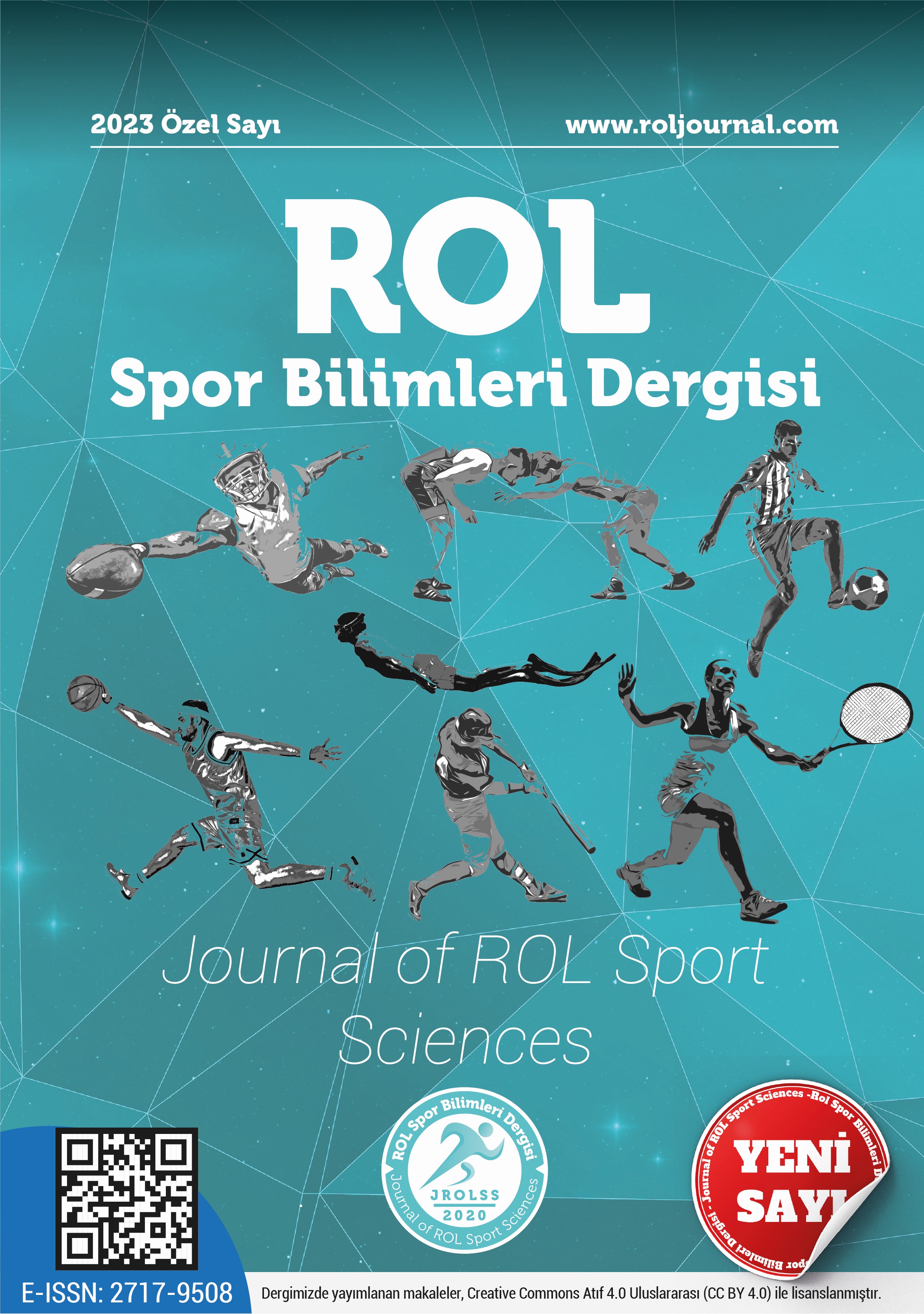A stepwise regression analysis on the effects of imagery and emotion regulation on courage level in athletes
DOI:
https://doi.org/10.5281/zenodo.10036854Keywords:
Athlete, imagery, emotion regulation, courageAbstract
The aim of this study is to determine the role of imagery and emotion regulation on the courage levels of athletes who continue their sports life as licensed in different sports branches. In line with this scope, a total of 609 athletes, 286 female and 383 male, participated in the study voluntarily. The research was designed with relational survey model. In the analysis of the data obtained in the study, missing data and extreme data analyses were performed first. Then, skewness and kurtosis values were examined for normality assumptions and it was determined that the distribution was normal. Accordingly, Pearson Product Moment Correlation analysis was used to determine the relationship between the variables and Stepwise Regression analysis was used to determine the power of the independent variables in predicting the dependent variable. When the findings obtained within the scope of the research are examined, the analysis regarding the effect of imagery, cognitive reappraisal and suppression factors on the level of courage was completed in one stage. While cognitive reappraisal and suppression did not significantly affect the level of courage, imagery significantly affected the level of courage and contributed approximately 17% of the variance. In addition, the positive relationship between imagery and courage level shows that these two will increase linearly.
References
Anuar, N., Cumming, J., & Williams, S. (2017). Emotion regulation predicts imagery ability. Imagination, Cognition and Personality, 36(3), 254-269.
Bandura, A. (1982). Self-efficacy mechanism in human agency. American Psychologist, 37(2), 122.
Cohen J. (1992). Statistical Power Analysis. Current Directions in Psychological Science, 1(3), 98-101.
Corlett, J. (2002). Virtue Lost: courage in sport. In. A. Hollowchak (Ed.), Philosophy in sport. new jersey: Prentice Hall;.
Creswell, J. W., & Creswell, J. D. (2017). Research design: Qualitative, quantitative, and mixed methods approaches: SAGE Publications.
Cumming, J., & Williams, S. E. (2012). The role of imagery in performance. S. M. Murphy (Ed.), In The Oxford handbook of sport and performance psychology (pp. 213-232). UK: Oxford University Press, 56-78.
D’Argembeau, A., & Van der Linden, M. (2006). Individual differences in the phenomenology of mental time travel: The effect of vivid visual imagery and emotion regulation strategies. Consciousness and Cognition, (15), 342-350.
Driskell, J. E., Copper, C., & Moran, A. (1994). Does mental practice enhance performance? Journal of Applied Psychology, 79(4), 481-492.
Evans, L., Jones, L., ve Mullen, R., (2004). An imagery intervention during the competitive season with an elite rugby union player. Sport Psychology. 18(3), 252–271.
George D., Mallery, P. (2016). IBM SPSS statistics 23 step by step: A simple guide and reference. New York: Routledge.
Gross, J. J. (1998). The emerging field of emotion regulation: An integrative review. Review of General Psychology, 2(3), 271-299.
Gross, J. J. (1998). The emerging field of emotion regulation: An integrative review. Review of General Psychology, 2(3), 271-299.
Gross, J. J. (1999). Emotion regulation: Past, present, future. Cognition & Emotion, 13(5), 551-573.
Gross, J. J. (2002). Emotion regulation: Affective, cognitive, and social consequences. Psychophysiology, (39), 281-291.
Gross, J. J., & Thompson, R. A. (2007). Emotion Regulation: Conceptual Foundations. In J. J. Gross (Ed.), Handbook of emotion regulation (pp. 3–24). The Guilford Press
Hanton, S., ve Jones, G. (1999). The effects of a multimodal intervention programme on performers: II. Training the butterflies to fly in formation. The Sport Psychologist, 13(1), 22–41.
Holmes, E. A., & Mathews, A. (2010). Mental imagery in emotion and emotional disorders. Clinical Psychology Review, 30(3), 349-362.
Holmes, E. A., Lang, T. J., & Shah, D. M. (2009). Developing interpretation bias modification as a" cognitive vaccine" for depressed mood: imagining positive events makes you feel better than thinking about them verbally. Journal of Abnormal Psychology, 118(1), 76.
Jing, X., Wu, P., Liu, F., Wu, B., & Miao, D. (2011). Guided imagery, anxiety, heart rate, and heart rate variability during centrifuge training. Aviation, Space, and Environmental Medicine, 82(2), 92-96.
Jones, M. V., Mace, R. D., Bray, S. R., MacRae, A. W., & Stockbridge, C. (2002). The impact of motivational imagery on the emotional state and self-efficacy levels of novice climbers. Journal of Sport Behaviour, 25(1), 57–73.
Kornspan, A. (2009). Fundamentals of sport and exercise psychology. Human Kinetics.
Kosslyn, S. M., Ganis, G., & Thompson, W. L. (2001). Neural foundations of imagery. Nature Reviews Neuroscience, 2(9), 635-642.
Lang, P. J. (1979). A bio‐informational theory of emotional imagery. Psychophysiology, 16(6), 495-512.
Mauss, I. B., Bunge, S. A., & Gross, J. J. (2007). Automatic emotion regulation. Social and Personality Psychology Compass, 1(1), 146-167.
Ochsner, K. N., & Gross, J. J. (2005). The cognitive control of emotion. Trends in Cognitive Sciences, 9(5), 242-249.
Peterson, C., & Park, N. (2004). (Classification and measurement of character strengths: ımplications for practice. Positive psychology in practice (pp. 433-446). Hoboken, NJ, US: John Wiley & Sons Inc.
Tabachnick L, Fidell, (2013) Using multivariate statistics (sixth ed.) Pearson, Boston.
Tingaz, E. O. & Altun-Ekiz, M. (2021). Duygu düzenleme ölçeğinin sporcular için uyarlanması ve psikometrik özelliklerinin incelenmesi. Gazi Beden Eğitimi ve Spor Bilimleri Dergisi, 26(2), 301-313. Retrieved from https://dergipark.org.tr/en/pub/gbesbd/issue/61222/886385
White, A., ve Hardy, L. (1998). An in-depth analysis of the uses of ımagery by high-level slalom canoeists and artistic gymnasts, The Sport Psychologist, 12(4), 387-403.
Wood, R., & Bandura, A. (1989). Social cognitive theory of organizational management. Academy of management Review, 14(3), 361-384.
Downloads
Published
How to Cite
Issue
Section
License
Copyright (c) 2023 Journal of ROL Sport Sciences

This work is licensed under a Creative Commons Attribution 4.0 International License.

